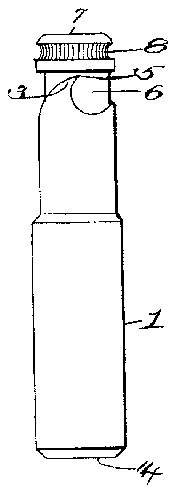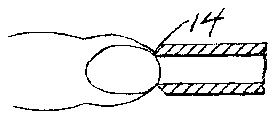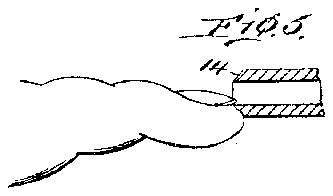



- 1body portion
- 2bevel
- 4notches
- 5points
- 6plug
- 8file
- 9tweezers
- 14cutting edge
Description
G. W. MOORE.
MANIGURING INSTRUMENT.
APPLIUATIOIfI FILED JAN. 21. 1909.
Patented Apr. 5, 1910.
W1 line/sow ANDREW s GRiRAM m woro'ummmmzns \msmumon n c GEORGE WASHINGTON MOORE, OF ATLANTA, GEORGIA.
MANICURING INSTRUMENT.
Specification of Letters Patent.
Patented Apr. 5, 1910.
Application filed January 27, 1909. Serial No. 474,482.
T 0 all whom it may concern:
Be it known that I, GEORGE W. Moons, a citizen of the United States, residin at Atlanta, in the county of Fulton and btate of Georgia, have invented certain new and useful Improvements in Manicuring Instruments; and I do hereby declare the following to be a full, clear, and exact description of the invention, such as will enable others skilled in the art to which it appertains to make and use the same.
This invention relates to improvements in finger and toe nail cutters.
The invention comprises the production of a cuttin device in combination with a plurality o auxiliary devices associated in operation with the cutting device.
The object in view is the production of an improved finger and toe nail cutter and cleaner that is easily operated, and is also easily sharpened when necessary.
With these and other objects in view the invention comprises certain novel constructions, combinations and arrangements of parts that will be hereinafter more fully described and claimed.
In the accompanying drawing: Figure 1 is a side elevation of one embodiment of the present invention. Fig. 2 is a vertical section through the structure seen in Fi 1. Fig. 3 is a side elevation of the same, 100 ing from a position at right angles to the point of observation of Fig. 1, the nail file attachment being omitted. Fig. 4 is a detail, fragmentary sectional view thereof in operation, the nail being seen in plan. Fig. 5 .is a similar view of the same taken at right an les to the plane of the section of Fig. 4.
n providing a tool according to the pres ent invention, I preferably make the combined holder and cutter in the form of a tubular body portion 1. Preferably, I construct the body 1 from steel so as to provide material that will hold a sharp cutting edge for a considerable length of time. At one end of the body 1, I provide a substantially half circle bevel, as at 2. The body 1 is also formed at the beveled end with curved notches or cut awafy ortions as 4, 4 at the opposite termini o tlie bevel 2, so that between notches 4 and bevel 2, projecting points are produced, which are designed to e used in cleaning the finger nails whenever desired. It is preferable to curve the ends of points 5, so as to cause each of the ends of bevel 2 to be formed on the arc of a circle as indicated at 3. The points are thus formed long and sharp for thoroughly cleaning or scraping the nails as may be desired, the curvature adapting the respective points 5 to fit the nail when drawn transversel across the end of the finger beneath the nai The opposite end of the body portion 1 is cut on a bevel to form a circular cutting edge 14 shown in operation in Figs. 4 and 5, the cutting edge 14 serving to cut or trim the nail when the instrument is moved bodily across the nail.
Removably positioned within the body portion 1 is a plug 6 formed at its outer end with a cap or disk 7 resting upon points 5 and constituting a guard therefor. The edge of the cap 7 is formed with an annular concaved file 8. The opposite end of the plug 7 is preferably provided with a pair of tweezers 9. It is to be noted that the file 8 is especially adapted for finishing the nail after the same has been trimmed and cleaned, and the tweezers may well be employed for lifting any portions of the nail that may have grown into the flesh or may be overhung thereby. It is thus obvious that the body portion of the present improved manicuring instrument may be provided with various auxiliary attachments as may be found desirable.
In operation when it is desired to cut or trim the finger nails, body portion 1 is placed with cutting edge 14 against the nail at any desired angle, as for instance at a substantial continuation thereof, and the body portion is then moved back and forth across the nail. This will gradually cut away the finger nail and at the same time force the flesh from each side of the nail a farther distance back. As clearly seen in Fig. 4, the cutting edge 14 spans part of the finger nail, and in dolng so permits part of the cutting edge to pass beneath the nail, and in this manner permits the nail to be cut off squarely or to be rounded at top or sides as may be desired. After the nail proper has been trimmed to a proper degree the points 5 may be used to push back the flesh or cuticle to any desired extent. The points 5 also ma be used to clean the under side of the nail after the manner of a knife or other pointed instrument.
What I claim is:
1. A manicuring instrument consistin of a tubular body portion having one 0 its ends provided with an annular beveled cuttin edge and provided at its opposite end Wll1 a rounded ortion cut out at an angle to the axis of t e tubular body to form a pair of cuttin edges.
2 In a manicurin instrument the combination of a tubular ody portion having an annular beveled cutting edge at one end a cleaning point at the opposite end, a tubular plug adapted to fit into the body portion, and a cap carried by the outer end of the plug and designed to constitute a guard for the point, the point being formed with a concave cutting edge adapted to act as a finishing tool.
3. In a manicuring instrument comprisin a tubular body portion having one of its en s provided with an annular beveled cutting1 edge, and provided at its opposite end wit a plug adapted to fit into said tubular portion, a pair of tweezers carried by said plug member and normally adapted to be positioned in said tubular member.
In testimony whereof I afiix my signature in presence of two Witnesses.
GEORGE WASHINGTON MOORE.
Witnesses H. HILL, J. R. WOODWARD.

